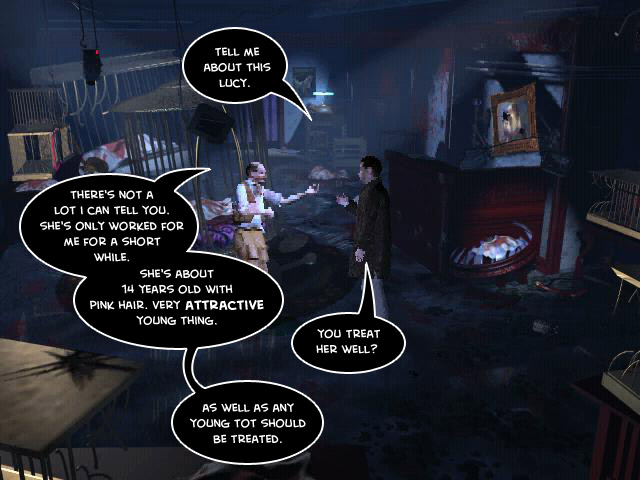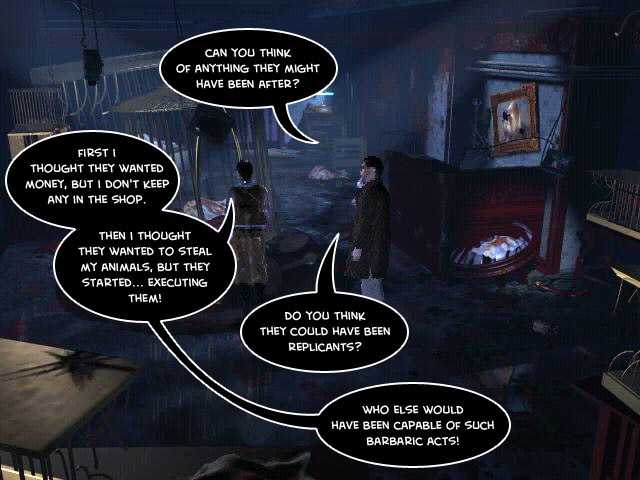Part 3: Act I - The Walls are the Wrong Shade of Monkey Guts
Act I - The Walls are the Wrong Shade of Monkey Guts
Everything up till now so far has been a cinematic, but I didn't want to kick off the thread by saying, "Here, watch a movie!", so...
To be fair, the whole game was designed to be as cinematic as possible. They made a number of concessions to accomodate the movie-like feel of it, at the expense of actual gameplay. Like a lot of other adventure games (hello there, Dreamfall), this game is sometimes more fun to watch than to play.
Here we are, the first taste of actual what the gameplay looks like. The backgrounds are prerendered, and then you've got your voxel characters moving around in front of it. They look terribly blocky and blurry because... well, the voxel technology wasn't used very well in this game. Still, you have to remember this was made in 1997, during the infant days of 3D games, when not everyone had even had an accelerator card. Polygon models still looked like this:

So it was a choice between blurry voxels, or chunky abstract people from Picasso's nightmares.
We're in control of Detective Ray McCoy, our main character. Gameplay is mostly the simple point-and-click from most adventure games. Now and again there's the more advanced discipline of, "Aim here and click", and once or twice there's, "Click here as fast as you can but oh god I can't click any faster", but that's about as complicated as it gets. The meat is in the story, so that's where I'll be focusing.
So, first thing we should pick up is the piece of chrome lying in the middle of the road, which apparently the fat cop missed.
We should also take a look at the fire hydrant...
Putting two and two together, we can conclude some Sunday driver backed his car into the fire hydrant and ripped part of his chrome bumper off. I know this because I did the same thing once, except instead of a fire hydrant, it was a parked Toyota Camry. With its owner still inside. And her kids. And a yapping dog. That was an awesome day at the insurance office.
...
Anyway, we can send the paint samples off to the police lab later for testing.
Welcome to the slaughter house. Runciter came out with just a broken arm, but we can't say the same for his little zoo here. They even put two bullets into the gorilla painting.
Those bastards.

Eww. Too bad we can't call Runciter out for fiddling with little girls just yet, but he'll get his later.
The name Runciter actually was drawn from another Philip K. Dick novel, Ubik, where the Runciter in question was a fatherly old man who ran a team of... anti-telepaths. That was a very strange book as well.

In the Future™, most of the animals have gone extinct (which is why animal murder is especially heinous), and so we're left with exotic pet dealers being in the upper class of society. It's kind of a combination of art seller and a luxury car dealership. In the book, Electric Sheep, animals also take on an almost religious significance - humans cling to their (real) animal ownership as a way to keep themselves grounded, when everything else, including religion, emotions, and even humans are artificially constructed.
The book was written in the hippie 60's, and it's harder to reconcile that reverant attitude towards animals with what we have today, which is more or less, 'pave over the endangered frogs to build a strip mall'. Yeehaw!
We can take a look at Lucy's desk where she use to work. First thing to pick up is the toy dog in the corner obviously, but there's a candy bar on the desk as well. Underneath the desk is a chopsticks wrapper; written on it is...
One last thing before we leave... there's a broken camera on the upper left ceiling.
So we've got three main leads right now - the camera footage, the restaurant in Chinatown, and the bits of leftover car outside. Next we'll take everything down to the police lab and get it analyzed.
While we're still introducing the gameplay, I mentioned Blade Runner tried to emulate as much of a cinematic feel as possible. That meant a complete lack of a UI during gameplay (except for the mouse pointer). There's also no subtitles for any of the dialog, to emulate the film, and to my great LPing dismay. They also did away with the traditional adventure game convention of having an inventory. Instead, you get a KIA 'clue' database, with visual and audio recordings of all the evidence you've gathered so far.
You can sort by type of evidence, crimes and case files, and cross reference by suspect... in other words, it's completely fucking overkill.
Still, it's better than collecting blue and red keys to your inventory or whatever, and getting clues means you can open up new dialog or new areas to travel to.
Blade Runner introduced some RPG elements into the adventure game formula - I mentioned there were about 12 or 13 variations of the endings, depending on choices in the game. To preserve the cinematic feel, they gave you the option of predetermining Ray's dialog via setting a 'mood' here. You can pick 'Emo Ray', 'Neutral Ray', 'Hardass Ray', and my favourite, 'Schizo Ray'. That one makes Ray have mood swings, from asshole one moment to nice guy the next. The last option, the question mark, lets the player select what dialog to say, like a traditional RPG dialog tree. That's the one we'll use.
There's also a semi-joke option here, the 'Designer Cut'. It's a homage to the Director's Cut version of the film, where the happy-feely ending and Harrison Ford's narrated voiceover were snipped out. If you click this option in the game, you no longer hear Ray's voiceover... except there's tons of important exposition in the narration. So really, it's stupid.